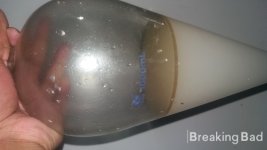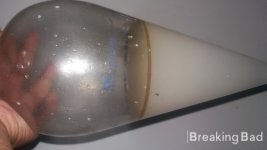- Joined
- Mar 2, 2023
- Messages
- 21
- Reaction score
- 13
- Points
- 3
Introduction
This is the modified preparation of P2P CAS 103-79-7 made using BMK Glycidic Acid ( sodium salt ) CAS 5449-12-7 with Phosphoric Acid 85% CAS 7664-38-2
Equipment and glassware:
Use a 3-neck Round bottom flask - on one neck you put the thermometer to measure the temperature of the liquid; on the second neck you put the distillation adapter with a condenser connected to the receiving flask, and on the third neck you put the dropping funnel.
Instruction:
For 50 gr batch
The reaction will begin immediately, and you will distil pure p2p into the receiving flask. The distillate will be milky water (similar to steam distillation). The reaction is complete once your distillate becomes clear water. The p2p should be extracted using 3 x 30 ml DCM (any other solvent will probably work), drying over molecular sieves/silica gel and evaporating the solvent.
When done correctly, the yield will be 80%+.
Important notes:
The method was done under the instruction and guidance of @w2x3f5, all credit goes to him.
This is the modified preparation of P2P CAS 103-79-7 made using BMK Glycidic Acid ( sodium salt ) CAS 5449-12-7 with Phosphoric Acid 85% CAS 7664-38-2
Equipment and glassware:
- 1000 ml 3-neck Round bottom flask
- Distillation adapter
- Condenser with a receiving flask
- Dropping funnel
- Thermometer to control liquid temperature
- Hot plate or Magnetic stirrer (do not place the flask
- Boiling stones (pieces of broken porous ceramics)
Use a 3-neck Round bottom flask - on one neck you put the thermometer to measure the temperature of the liquid; on the second neck you put the distillation adapter with a condenser connected to the receiving flask, and on the third neck you put the dropping funnel.
Instruction:
For 50 gr batch
- Pour 100 - 150 ml of Phosphoric acid into the flask, add boiling stones (3 - 4 pea size porous ceramic) and heat to 110 °C
- Dissolve the BMK sodium salt in boiling water (optimally 12 ml of water per 1 g of BMK sodium salt) and add to the dropping funnel
- Slowly add the dissolved solution into the acid drop by drop
The reaction will begin immediately, and you will distil pure p2p into the receiving flask. The distillate will be milky water (similar to steam distillation). The reaction is complete once your distillate becomes clear water. The p2p should be extracted using 3 x 30 ml DCM (any other solvent will probably work), drying over molecular sieves/silica gel and evaporating the solvent.
When done correctly, the yield will be 80%+.
Important notes:
- Do not place the flask directly on the hotplate, use tripod stand
- Boiling stones are very important if you do not use a stirrer
- The addition of dissolved glycidic acid should be slow (drop by drop using dropping funnel) for good yield - be patient
- The temperature should be maintained at 110 °C, not higher
The method was done under the instruction and guidance of @w2x3f5, all credit goes to him.
Attachments
Last edited:


